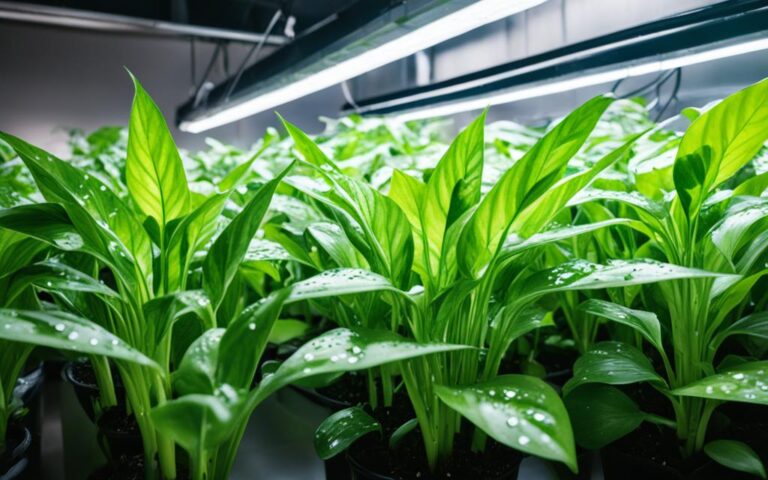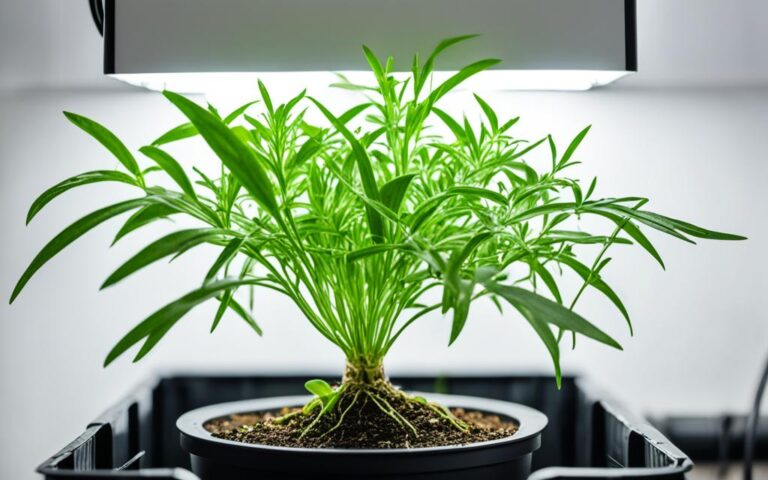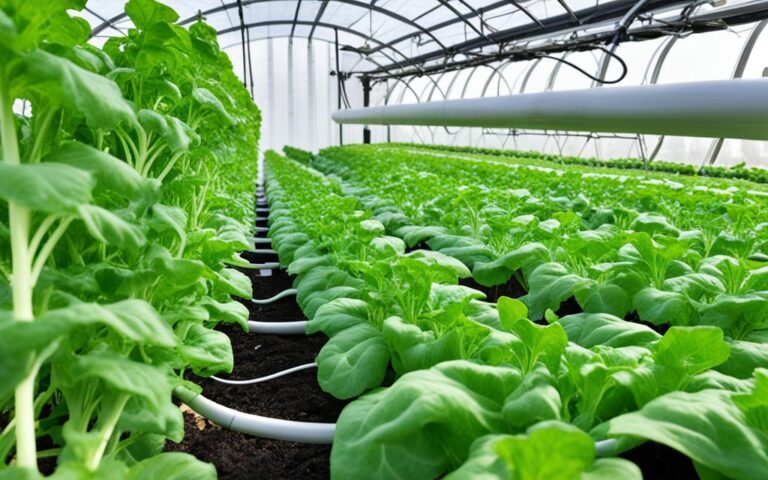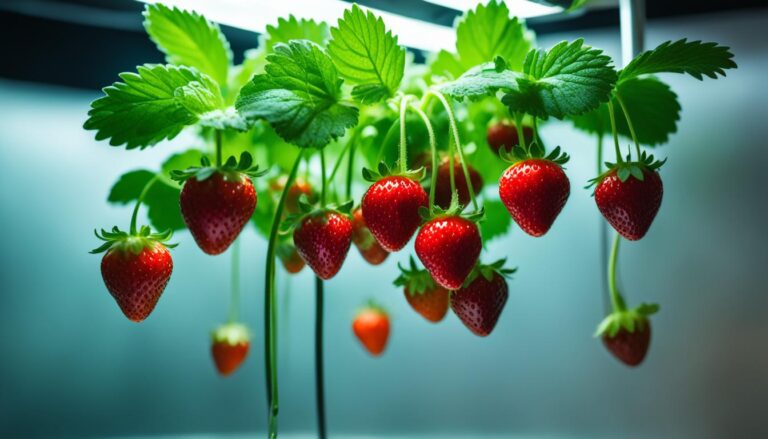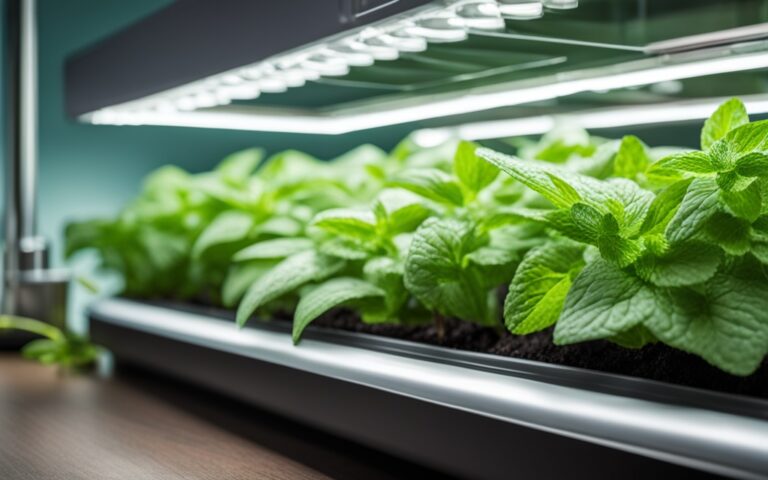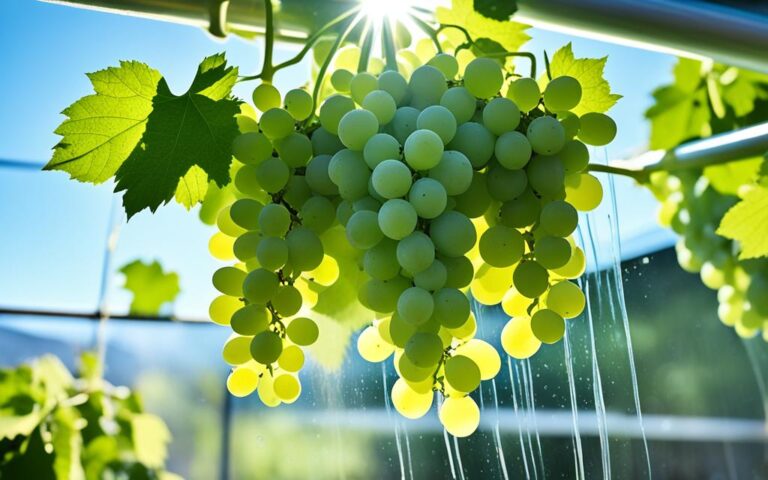Grow Fresh Hydroponic Cucumbers at Home
Welcome to home hydroponics. Here, you can grow fresh cucumbers right outside your door. It doesn’t matter what the season is. Urban gardening is getting more popular, and sustainable cultivation is a big deal. That makes growing hydroponic cucumbers both easy and rewarding for many gardeners.
With the right hydroponic cucumber setup, you get a lot of benefits. Things like using less space, saving water, and having cucumbers all year long. Just picture grabbing a fresh cucumber from your kitchen anytime. That’s how awesome hydroponics is.

Key Takeaways
- Hydroponic cucumbers offer a sustainable cultivation method for home gardeners.
- Urban gardening trends support the practice of growing hydroponic cucumbers.
- A well-managed hydroponic setup provides year-round harvests.
- Benefits include efficient use of space and water resources.
- Home hydroponics ensures fresh produce at your convenience.
Introduction to Hydroponic Cucumbers
The idea of growing cucumbers hydroponically is changing how we farm, especially in cities. Space is often limited in urban areas. But with indoor farming, fresh cucumbers can be grown all year, no matter the weather outside.
Hydroponic farming gives us exact control over nutrients and the environment. This ensures lots of high-quality cucumbers. It’s an ideal solution for crowded cities, avoiding the need for a lot of farmland.
One big perk of growing indoors is using less water. Unlike traditional farming, hydroponics recycles water, cutting down waste. Plus, it lessens the need for pesticides and herbicides, leading to healthier produce.
Hydroponic urban farms also cut down on food miles. This means cucumbers are grown closer to where they’re eaten. It shortens the trip from farm to plate, saving fuel and cutting pollution.
To wrap it up, hydroponic cucumber farming is a big step forward. It gives us a way to grow fresh, healthy cucumbers right in our cities. It’s sustainable and efficient, making it great for our future.
Best Hydroponic Cucumber Varieties
Picking the best cucumber variety is key for top yield and flavor in hydroponic gardens. We will look at three types that do very well in hydroponic systems.
English Cucumbers
Hydroponic English cucumbers are long and have a light taste. They have few seeds, which is great for fresh salads and sides. They also produce a lot in controlled environments.

Persian Cucumbers
Persian cucumber hydroponic varieties are small with a crunchy feel and slightly sweet flavor. They are great for snacks and dishes needing a crisp texture. They fit well in tight spaces, ideal for vertical hydroponic systems.
Bush Varieties: Spacemaster
If your space is tight, consider bush cucumbers like ‘Spacemaster’. They grow in small spaces and are great for compact hydroponic setups. They still yield lots of tasty cucumbers, making them a smart choice for city gardeners.
Choosing the best hydroponic cucumber seeds leads to great gardening results. Whether you go with hydroponic English cucumber, Persian cucumber hydroponic, or ‘Spacemaster’, each has benefits that fit different setups and taste preferences.
Benefits of Growing Hydroponic Cucumbers
Growing cucumbers hydroponically brings big advantages over traditional soil farming. It offers a forward-thinking way to overcome gardening hurdles with sustainability in mind.
Water Efficiency
Water savings is a major plus of hydroponic cucumbers. These systems need up to 90% less water than traditional gardens. They recycle water in a loop, cutting down waste. This is great for saving water, especially in dry areas.
Space Efficiency
Hydroponics is also great for saving space. You can grow plants up or in small spots, making the most out of the room you have. In cities, where garden space is rare, this is a key benefit. Hydroponics lets you grow more cucumbers in less space.
Year-Round Harvest
With hydroponics, you can get cucumbers all year. It doesn’t matter what the season is. You can grow them inside under controlled conditions. This means always having fresh cucumbers and not worrying about bad weather.
In short, growing cucumbers hydroponically saves water, uses space well, and gives you cucumbers any time. These benefits make it a smart, eco-friendly choice for growing cucumbers.
Choosing the Right Hydroponic System for Cucumbers
Choosing the right hydroponic setup for cucumbers is key to good yields. There are different systems, each with its own benefits. Today, let’s look into Deep Water Culture (DWC), Nutrient Film Technique (NFT), and Ebb and Flow systems for growing cucumbers.

Deep Water Culture (DWC)
The DWC system is simple but effective for cucumbers. It keeps cucumber roots in nutrient-rich water with lots of oxygen. This system is loved for its continuous nutrient and water supply. This results in quick growth and lots of cucumbers.
- Advantages: Efficient nutrient uptake, low maintenance, great for beginners.
- Disadvantages: Risk of root diseases if not enough oxygen.
- Best For: Small to medium setups.
Nutrient Film Technique (NFT)
NFT lets nutrient solution flow constantly over cucumber plant roots. It’s great for saving water and is very efficient. This makes it an excellent choice for cucumber growers.
- Advantages: More oxygen, uses less water, good for big operations.
- Disadvantages: If the pump fails, plants can get stressed quickly.
- Best For: Larger setups.
Ebb and Flow Systems
Ebb and Flow, also known as Flood and Drain, floods the grow tray with nutrients and then drains it. It’s flexible and perfect for cucumbers, especially when you don’t have much space.
- Advantages: Flexible, good nutrient delivery, great for the roots.
- Disadvantages: Needs careful timing, roots may dry if not managed right.
- Best For: Small to medium operations with plants of different heights.
| System Type | Advantages | Disadvantages | Best For |
|---|---|---|---|
| Deep Water Culture (DWC) | Efficient nutrient uptake, low maintenance | Risk of root diseases if oxygen levels drop | Small to medium-scale setups |
| Nutrient Film Technique (NFT) | High oxygen levels, minimal water usage | Pump failure can lead to plant stress | Medium to large-scale setups |
| Ebb and Flow | Versatile, efficient nutrient delivery | Requires precise timing, potential root drying | Small to medium-scale setups |
Selecting and Preparing Cucumber Seeds
Starting your hydroponic cucumber garden begins with the right seeds. It’s essential to choose high-quality seeds. This choice plays a big role in how well the plants will grow.
Germinating Seeds
First, germination is key for growing cucumbers hydroponically. Pick seeds from trusted suppliers to ensure your plants will be healthy. Soak the seeds for 12 to 24 hours to help them sprout faster.
After soaking, place the seeds in a moist paper towel. Then, put this in a plastic bag and keep it in a dark, warm spot. Soon, you’ll see roots beginning to form. That means they’re ready to move to the next stage.
Transplanting Seedlings
With roots showing, it’s time to transplant the seedlings into your hydroponic setup. Be gentle with the delicate roots to avoid harm. They should go into a supportive medium like rockwool or coco coir.
The right nutrient mix is crucial at this stage. Use a fertilizer high in nitrogen for the best growth. Keep the pH level between 5.5 and 6.0 to help plants get more from the nutrients.
Considerations for Self-Pollinating Varieties
For hydroponics, self-pollinating cucumber types are great. You don’t need bugs or to pollinate by hand, which makes things easier. Plus, you get more cucumbers with less work.
‘Parthenocarpic’ cucumbers are a good option. They bear fruit without needing pollination. These types give you a steady harvest in a hydroponic system, making your efforts more fruitful.
| Step | Details |
|---|---|
| Germinating Seeds | Soak in water, place in a damp environment. |
| Transplanting Seedlings | Move to growing medium, ensure balanced nutrients. |
| Self-Pollinating Varieties | Select parthenocarpic types for easier cultivation. |
Setting Up Your Hydroponic Cucumber System
Starting a hydroponic cucumber system is fulfilling. First, get the right equipment. This means picking suitable containers, setting up pumps, and getting your lights right.

Container Selection
Choosing good containers is key to success. Look for strong, safe containers that fit your cucumber tower well. They should be big enough for the roots and nutrient solutions.
Installing Pumps and Aeration
Good water movement is vital. Use dependable pumps for the nutrient solution. Add aeration tools to give roots enough oxygen. This helps cucumbers grow well and stops root rot.
Lighting Setup
Light is crucial for growing cucumbers inside. Use LED lights that offer a full light spectrum. Make sure the lights reach all parts of your cucumber setup evenly.
Nutrient Solution Preparation and Management
Preparing and managing the right nutrient solution is vital for hydroponic cucumbers to thrive. It’s key to know what nutrients they need. Keeping an eye on pH levels and understanding EC and TDS is crucial. This leads to a successful hydroponic system for cucumbers.
Essential Nutrients
For balanced growth, hydroponic cucumbers need a mix of key macro and micronutrients. Nitrogen, phosphorus, and potassium are crucial macronutrients. They help the plant grow, flower, and bear fruit. Other important macronutrients are calcium, magnesium, and sulfur.
Micronutrients like iron, manganese, zinc, copper, molybdenum, and boron are also vital. Though needed in smaller amounts, they are crucial for the plant’s health.
Monitoring pH Levels
For hydroponic cucumbers, keeping the right pH level is crucial because it affects how plants take up nutrients. They do best in a pH range from 5.5 to 6.5. Use pH meters or strips to check it regularly.
Adjust the pH as needed with pH-up or pH-down solutions. This keeps the levels just right. Doing so prevents the plants from getting too little or too many nutrients.
Optimal EC and TDS Ranges
Keeping an eye on EC and TDS levels is crucial in hydroponic solutions. EC tells you how many nutrients are in the solution. A good EC range for cucumbers is 1.8-2.4 mS/cm.
TDS measures all dissolved particles in the solution. The ideal range is around 1260-1680 ppm. By monitoring these values, you ensure the nutrient solution is perfect for cucumber growth.
Light and Temperature Requirements for Hydroponic Cucumbers
For hydroponic cucumbers to do well, it’s key to get the light and temperature right. As they grow in a controlled setting, the right lighting and temperature are vital. Choosing the correct lighting and keeping the temperature just right helps beat common problems.
Types of Grow Lights
Picking the right grow lights is crucial for hydroponic cucumbers. LED grow lights for cucumbers are the top choice. They save energy and offer the full light spectrum needed for growth. High-Intensity Discharge (HID) lights, like Metal Halide (MH) and High-Pressure Sodium (HPS), are options too. But, they use more energy and make more heat.
Temperature Control
Keeping the right temperature is key for hydroponic cucumbers. During the day, aim for 75-85°F (24-29°C). At night, cool it down to 65-70°F (18-21°C). Heaters, fans, and air conditioners help keep the temperature steady. This avoids problems due to temperature changes.
Light Duration Recommendations
Hydroponic cucumbers need 14-16 hours of light every day for strong growth. Using timers with your LED grow lights for cucumbers makes this easy. It ensures the plants get light regularly. It’s also important to give them 8-10 hours of darkness. This rest time lets them process nutrients well.
Hydroponic Cucumber Pest and Disease Management
Keeping cucumbers healthy in hydroponic systems means managing pests and diseases well. Without soil, the challenges don’t disappear; they just change. Using effective organic methods to control pests and prevent issues is key for a successful cucumber garden.
Common Pests
Hydroponic cucumbers face threats from pests like aphids, spider mites, whiteflies, and fungus gnats. Aphids, which are tiny bugs that suck on plants, can cause cucumbers to grow oddly and might spread diseases. Spider mites damage plant health with their webbing. Whiteflies also harm plants by feeding on them.
Preventive Measures
Preventing problems starts with keeping everything clean. By cleaning your hydroponic gear regularly, you can fight off many pest-related issues. Adding good bugs like ladybugs or predatory mites helps keep the bad bug population down. Sticky yellow traps also help control whiteflies and fungus gnats.
Natural Remedies
There are natural ways to control pests too. Neem oil works great against many types of pests, including aphids and spider mites. Soapy water can also kill pests like aphids and whiteflies without hurting the cucumbers. And a spray made from garlic can keep pests away while keeping the plants safe.
Pollination Techniques for Indoor Hydroponic Cucumbers
To get a lot of cucumbers from your indoor hydroponic garden, pollination is key. Let’s look at different ways to make sure your cucumbers are pollinated well.
Hand Pollination
Hand pollination means manually moving pollen from male to female flowers. It’s vital when you don’t have bees or other pollinators around. Here’s how to do hand pollination:
- Use a small brush or cotton swab to collect pollen from the male flower.
- Gently brush the collected pollen onto the stigma of the female flower.
- Perform this process in the morning for best results.
Using Pollinator Devices
If you find hand pollination hard, there are machines that can help. These devices act like bees to spread the pollen:
- Electric pollinators: They vibrate to shake pollen loose and move it to female flowers.
- Air blowers: These blowers spread pollen gently in your grow area.
Both ways work well for getting even pollination in hydroponic setups.
Selecting Self-Pollinating Varieties
A great tip is to choose cucumber seeds that pollinate themselves. You won’t need to pollinate these by hand or machine. Here’s why they’re good:
- They fruit on their own, without needing bees.
- They make your hydroponic garden easier to take care of.
Picking self-pollinating seeds means you’ll have lots of cucumbers with less work.
Using these pollination strategies will greatly increase your cucumber yield indoors.
Hydroponic Cucumber Yield Maximization Tips
To boost your hydroponic cucumber yield, follow some key strategies. Focus on proper pruning and use trellises for support. Don’t forget about the right nutrient management.
Pruning Techniques
Pruning boosts hydroponic crop production significantly. By cutting away extra leaves and shoots, plants spend energy on growing cucumbers. This also lets air flow better, keeping diseases away.
Trellising and Support
For supporting vines and increasing yield, trellising is great. Vertical supports help plants grow up. This makes for better light reach and simpler harvesting.
Optimal Nutrient Schedules
Following the right nutrient plan is key for healthy cucumbers. Keep an eye on the nutrient solution and adjust as needed. Plants thrive with all the right nutrients, boosting yields.
Common Issues and Troubleshooting Hydroponic Cucumbers
Growing cucumbers with hydroponics can be fulfilling. Yet, growers often face several challenges. Spotting and managing these issues quickly helps ensure your plants grow healthy and produce well.
Nutrient balance is critical for cucumbers grown this way. These plants need a balanced diet to flourish. If they lack nutrients, you might see yellow leaves, stunted growth, or poor fruit. Check and adjust your nutrient solution regularly to avoid these problems.
Inadequate Pollination
Sometimes, cucumbers don’t get pollinated enough, especially indoors. This results in less fruit and oddly shaped cucumbers. To fix this, use hand pollination or tools that help pollinate your plants.
Here’s a comprehensive list of common hydroponic cucumber issues and how to solve them:
| System Component | Purpose | Recommended Options |
|---|---|---|
| Containers | Hold roots and nutrient solution | Sturdy, non-toxic, adequate size |
| Pumps | Circulate nutrient solution | Reliable, energy-efficient models |
| Aeration Devices | Provide oxygen to roots | Air stones, air pumps |
| LED Grow Lights | Light for photosynthesis | Full-spectrum, adjustable intensity |
| Issue | Symptoms | Troubleshooting Tips |
|---|---|---|
| Nutrient Deficiency | Yellowing Leaves, Stunted Growth | Check and Adjust Nutrient Levels Regularly |
| Inadequate Pollination | Poor Fruit Set, Misshapen Cucumbers | Hand Pollinate, Use Pollinator Devices |
| Root Rot | Wilting, Brown Roots | Ensure Proper Aeration, Avoid Overwatering |
| pH Imbalance | Poor Nutrient Uptake | Maintain pH Levels Between 5.5 – 6.5 |
By carefully watching and fixing problems in your hydroponic system, your cucumber plants will thrive. With attention and care, you’ll get plenty of tasty cucumbers grown hydroponically.
Harvesting and Storing Hydroponic Cucumbers
Harvesting cucumbers grown hydroponically can be very fulfilling. However, it’s important to pick them at the right time. Also, storing them correctly lets you enjoy fresh cucumbers for weeks.
When to Harvest
Knowing when to pick hydroponic cucumbers is key. Slicing varieties are ready at 6-8 inches. For pickling, wait until they are about 4 inches. Feel for firmness and look for a bright color to know they’re ripe.
Proper Harvest Techniques
Be careful not to harm the plant or its fruits. Use sharp pruning shears. Snip the cucumbers off at the stem, and leave some stem attached. This stops the fruit from rotting and helps the plant keep growing well.
Storage Tips
Properly storing hydroponic cucumbers is crucial for keeping them fresh. Store them at 50-55°F in a humid environment. Putting them in perforated bags keeps them moist.
| Storage Condition | Optimal Temperature | Humidity Level | Storage Duration |
|---|---|---|---|
| Refrigerator | 50-55°F | High | 1-2 weeks |
| Cool Storage Room | 50-55°F | High | 1 week |
Check your cucumbers regularly and adjust moisture when needed. This will greatly extend their freshness. By mastering these steps, you’ll enjoy a plentiful and efficient hydroponic harvest.
Conclusion
Hydroponic cucumber cultivation brings a new twist to city farming. It saves water and space while allowing for harvests all year. By picking suitable cucumber kinds, creating a good hydroponic setup, and carefully managing nutrients and light, gardeners can thrive.
One top advantage of hydroponic cucumbers is their sustainability. They let us grow food without soil and use less water. This method helps city folks live more sustainably and eco-friendly. Fighting pests and improving yields are part of reaching a bountiful cucumber harvest.
Now’s the perfect time to start this exciting hobby. Use what you’ve learned here to build your own hydroponic cucumber system. Feel the joy of hydroponic garden success, and savor the fresh, crisp cucumbers you’ve grown yourself.
FAQ
What are the benefits of growing cucumbers hydroponically?
Growing cucumbers hydroponically saves water and space. You can grow them all year round. It lets you control the plant’s food and environment for best growth. This way is also great for cities.
Which cucumber varieties are best for hydroponic systems?
For hydroponics, English, Persian cucumbers, and ‘Spacemaster’ bush varieties are top choices. They grow well in these systems, yield well, and are great for cooking.
What types of hydroponic systems are suitable for growing cucumbers?
Deep Water Culture (DWC), Nutrient Film Technique (NFT), and Ebb and Flow systems work well for cucumbers. Each has its own setup and pros and cons, based on your needs and system size.
How do I select and prepare cucumber seeds for hydroponic growing?
Pick top-quality seeds made for hydroponics. Start them in a good medium until they sprout. Move the young plants to your hydroponic system with care. Make sure everything’s perfect for them to grow. Think about choosing varieties that pollinate themselves if you’re growing indoors.
What are the essential nutrients for hydroponic cucumbers?
Hydroponic cucumbers need a balanced diet of nitrogen, phosphorus, potassium, calcium, magnesium, and trace elements. Keeping an eye on nutrients and pH levels is key for happy, healthy plants.
How do I monitor and maintain pH levels in a hydroponic cucumber system?
Use pH meters or test kits to check the pH of your nutrient solution regularly. Cucumbers like a pH between 5.5 and 6.5. Adjust it as needed to keep your plants growing strong.
What kind of lighting is best for hydroponic cucumbers?
LED grow lights are the best choice for hydroponics. They give plants all the light they need to make food through photosynthesis. Make sure your lights are in the right spot and on long enough to get the best growth and harvest.
How can I control temperature for indoor hydroponic cucumbers?
Keep the temperature between 68-75°F (20-24°C) for the best results. Use fans, heaters, or air conditioners to keep the climate stable. This protects your plants from too much heat or cold.
What are common pests and diseases that affect hydroponic cucumbers?
Watch out for aphids, spider mites, and whiteflies. Problems like powdery mildew and root rot can also happen. Keep things clean, use natural pest control, and manage air flow and moisture to prevent these issues.

